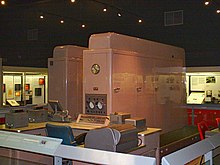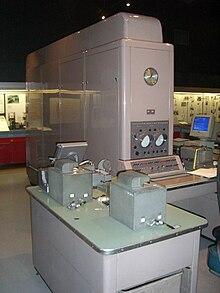

Pegasus was an early British vacuum-tube (valve) computer built by Ferranti, Ltd that pioneered design features to improve usability for both engineers and programmers.[1][2][3] It was originally named the Ferranti Package Computer as its hardware design followed that of the Elliott 401 with modular plug-in packages.[4] Much of the development was the product of three men: W. S. (Bill) Elliott (hardware); Christopher Strachey (software) and Bernard Swann (marketing and customer support).[5] It was Ferranti's most popular valve computer[6] with 38 units being sold. The first Pegasus was delivered in 1956[7] and the last was delivered in 1959. Ferranti received funding for the development from the National Research Development Corporation (NRDC).[8]
At least two Pegasus machines survive today, one in The Science Museum, London and one which was displayed in the Science and Industry Museum, Manchester but which has now been moved to the storage in the Science Museum archives at Wroughton. The Pegasus in The Science Museum, London ran its first program in December 1959 and was regularly demonstrated until 2009 when it developed a severe electrical fault.[9][10] In early 2014, the Science Museum decided to retire it permanently,[11] effectively ending the life of one of the world's oldest working computers. The Pegasus officially held the title of the world's oldest computer until 2012, when the restoration of the Harwell computer was completed at the National Museum of Computing.
- ^ Ferranti Computers 1953-64 (PDF), Museum of Science & Industry, 2011, archived from the original (PDF) on 2 October 2014, retrieved 15 November 2014.
- ^ Merry, Ian (Autumn 1993), "The design of Pegasus", Resurrection: The Bulletin of the Computer Conservation Society (7), ISSN 0958-7403.
- ^ Pegasus – a vintage British computer, University of Essex.
- ^ Lavington (1980), p. 79.
- ^ Ross (2012), p. 1.
- ^ Burton, Chris (18 November 2003), "Ferranti Pegasus, Perseus and Sirius: Delivery Lists and Applications" (PDF), CCS-F3X1 (4), retrieved 18 June 2022.
- ^ "COMPUTERS, OVERSEAS: 3. PEGASUS, Ferranti Limited, England". Digital Computer Newsletter. 8 (3): 11. Jul 1956.[dead link]
- ^ Lavington (1980), p. 102.
- ^ The Pegasus Incident and its Aftermath, retrieved February 23, 2018.
- ^ The Science Museum (2015).
- ^ Computer Conservation Society Projects list, retrieved June 8, 2014.